Experience
A Tradition Felt by the Eyes and Body
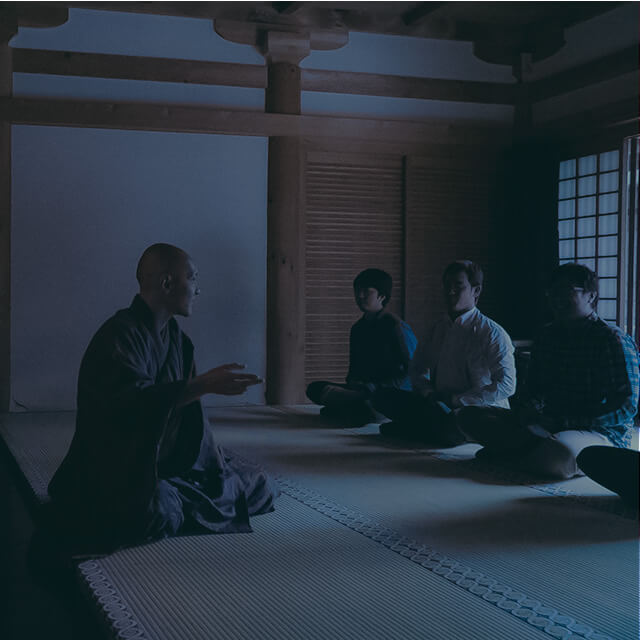
阿字観
ajikan
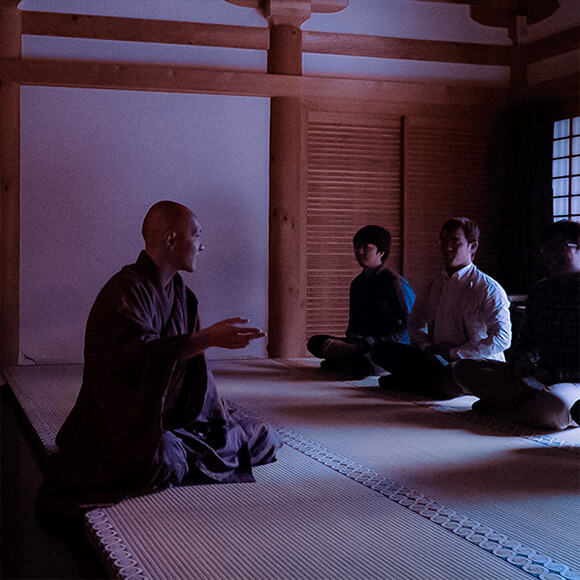
experience01
Take a breather with ajikan meditation
“At Sohonzan Kongobuji, you can practice ajikan meditation at Banryutei, Japan’s largest rock garden, which is ordinarily closed to the public. Ajikan is a form of breathing exercise and meditation practiced in Shingon Buddhism.
Meditate in tranquility amidst the pure aura of Mount Koya, still the mind, and leave your busy life. Monks are on hand to guide beginners, so this is an excellent addition to your visit to Kongobuji.”
※ Ajikan meditation is conducted in only Japanese.
Schedule
- Schedule
-
Four days a week (Fri, Sat, Sun, Mon)
April 20, 2024 through November 18, 2024
Note that the schedule and time may be subject to change based on other events at Kongobuji.
- Time
-
Held four times daily (for one hour)
9:30 11:30 13:30 15:30
Capacity: 14 persons per session
- Location
-
Sohonzan Kongobuji Ajikan Dojo
Register at the charms counter at the back of Kongobuji. Note that places are offered on a first come, first served basis. First pay the ¥1000 entrance fee (non members) at the main window.
- Entrance fee
-
Entrance fee: ¥1,000
- Reservations
-
※You can apply for an Ajikan meditation from website below.
more KOYASAN (Ajikan)
- Send inquiries and registration requests to:
-
132 Koyasan, Koyacho, Itogun,
Wakayama Prefecture, 648-0294
Sohonzan Kongobuji Religious Studies Department
ATTN: Koyasan Ajikan Instructor
TEL:0736-56-2014
FAX: 0736-56-4640
(Weekends: dial 0736-56-2015)
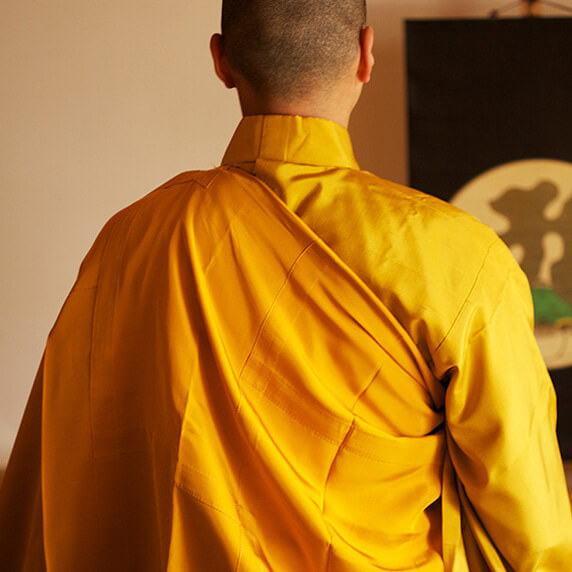
experience02
Ajikan Workshop
This session is led by an experienced ajikan expert from Sohonzan Kongobuji.
This is an opportunity to experience more intense ajikan meditation. Open to those who have practiced ajikan at least once before. (You will first be given an initiation at the Taishi Kyokai.)
Schedule
- Schedule
-
November 10(Sun)2024
Note that the instructor and schedule may be subject to change based on other events at Kongobuji.
- Time
-
“Reception open from 12:00 to 12:30. Workshop from 13:00 to 15:00.”
- Location
-
Mount Koya Taishi Kyokai
Note that this location differs from the usual Ajikan Dojo.
- Entrance fee
-
¥3,000/person (includes initiation fee)
- Reservations
-
Please call the Kongobuji Education Section.
TEL: 0736-56-2014 FAX: 0736-56-4640
Weekdays 8:30 to 17:00
授戒
sutras(Jukai)
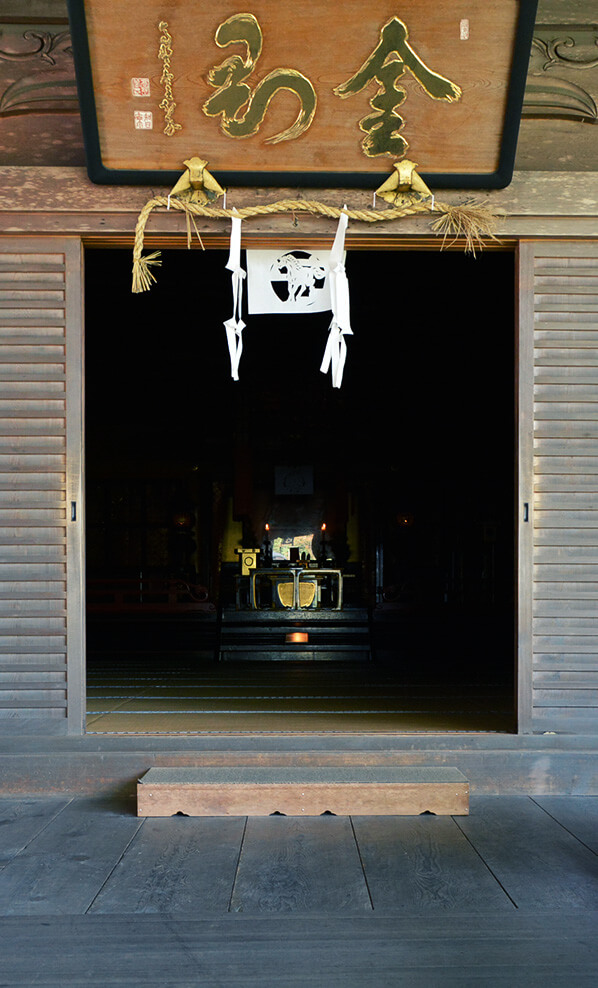
experience01
Sutras
In this practice, the teachings of the Buddha are received directly in a sermon from a high monk. This is one of the most emblematic traditions of Mount Koya and is available for participation year-round.
The Ten Precepts described therein were popularized through the ages as an accessible form of teaching for lay people. They describe codes of conduct that now, more than ever, are relevant to modern society. If people everywhere lend an ear to these precepts, we can achieve a better, richer society. They describe proper conduct and poise of mind.
Schedule
- Location
-
Koyasan Daishi Kyokai Scripture Hall
- Capacity
-
50名
- Entrance Donation
-
We request an offering of ¥1,000 per person.
- Reception hours
-
Please complete entrance procedures no later than ten minutes before the event is to start.
- Start time
-
第1回 9:00 第2回 10:00 第3回 11:00
第4回 13:00 第5回 14:00 第6回 15:00
第7回 16:00
- Length
-
about 30 minutes
- Reservation
-
※You can apply for Sutras from website below.
more KOYASAN (Sutras)
- Note
-
Once the ceremony begins, you may not leave the premises partway through.
- Inquiries
-
347 Koyasan, Koyacho, Itogun,
Wakayama Prefecture, 648-0294
Koyasan Daishi Kyokai
ATTN: Koyasan Ajikan Instructor
TEL: 0736-56-2015
FAX: 0736-56-4502
写経
shakyou
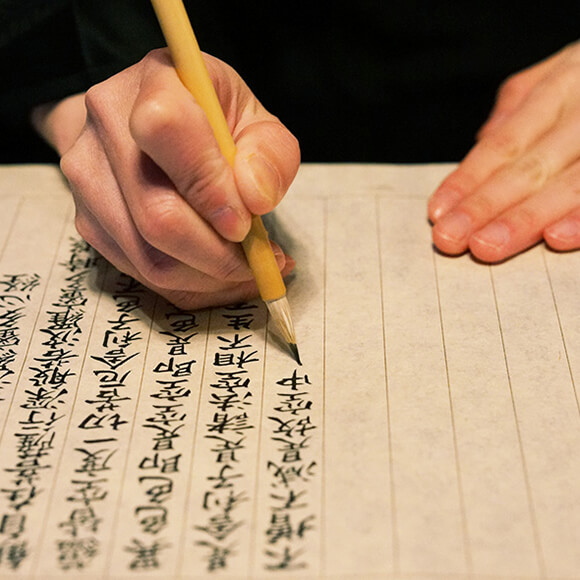
experience01
Shakyo
In an essay on the Heart Sutra, Kobo Daishi praises the sutra, saying that, in a text that reaches no more than 14 lines and is under a page, it gets to the essence of the Shingon teachings extolled by the Hannya Boddhisatva. Though simple in scope, its meaning is profound. He adds that deeply reading and reciting this sutra and performing services will bring salvation to the suffering; studying the scripture intently will lead to enlightenment.
Please join us in copying this sutra one character at a time, paying close attention to the meaning contained in every word. If you focus your entire action on this task, you will forget idle thoughts and still your mind. We recommend this activity as a way to develop a tranquil, bountiful state of mind.
Schedule
- Location
-
Koyasan Daishi Kyokai Shakyo Classroom
- Admission fees
-
¥1,500
- Reception Hours
-
Open every day from 8:30 AM to 3:00 PM.
*Note that other events may take precedence over this one on certain days.
*Limited to parties of 1-10 persons.
- Inquiries
-
347 Koyasan, Koyacho, Itogun,
Wakayama Prefecture, 648-0294
Koyasan Daishi Kyokai
ATTN: Koyasan Ajikan Instructor
TEL: 0736-56-2015
FAX: 0736-56-4502
experience02
Buddhism and Shakyo
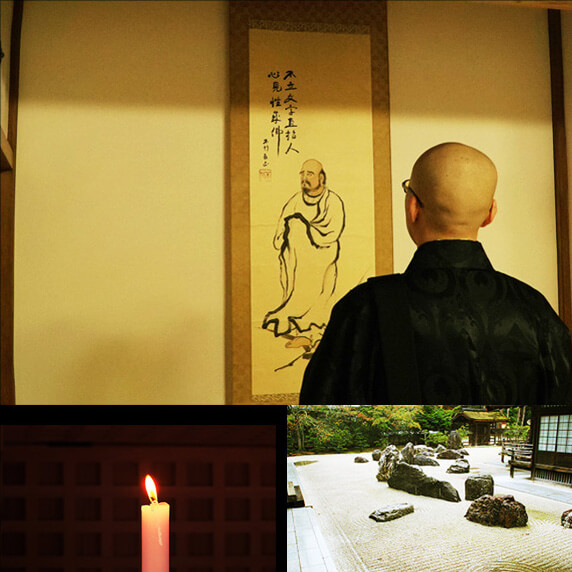
Shakyo is the act of copying sutras by hand. The teachings of the Shakyamuni Buddha were transmitted orally, but after Shakyamuni entered nirvana, one of his disciples, Mahakasyapa, appealed to his monk brothers the importance of properly copying down the teachings, and they were compiled for the first time. The compiled scriptures reached Sri Lanka in the first century BC in a Theravada form in the Pali language. Today, they are widely used in Buddhist countries in East Asia like Sri Lanka, Thailand, and Myanmar. In China, from the 2nd through 11th centuries, the scriptures were translated into their Chinese equivalent. The famous monks Xuanzang and Yijing, who traveled from China to India, as well as noted monks who translated the scriptures, like Kumarajiva and Bodhiruci, were active during this time. Subhakarasimha and Amoghavajra, considered among the great ancestors of the Shingon sect, also translated numerous scriptures, contributing to the spread of Buddhist culture. Because printing technology was still limited at the time, text could only be copied by hand, and the act of copying the scriptures came to be seen as one path to enlightenment.
Looking back to history, apocryphal sutras were deliberately composed in China, and the emerging need for translation, collection, and categorization of numerous texts, as well as differentiation between authentic and apocryphal documents, led to Dao An’s compilation in the late 4th century of a catalogue of scriptures. Sengyo contributed his own “Collected Records Concerning the Tripitaka” in the early 6th century. The works referenced therein were referred to as the “complete scriptures” by the Wei Dynasty (386-534) and the “Tripitaka” by the Liang Dynasty (502-557). By the time of the Sui (581-618) and T’ang (618-907) Dynasties, the custom of copying 17 characters to a line had taken root. The Nihon Shoki records that in 637 at Kawara-dera Temple in Nara, shakyo was conducted.
This is held to be the start of the sutra copying tradition in Japan. In the Nara period, the equivalent of today’s national libraries was created, and Confucian texts and Buddhist scriptures and images were stored there. These facilities were staffed by persons involved in copying manuscripts and binding them, pursuing the finest aesthetic refinements in their creation.
Sutra copying continued to spread as a model for language learning among laypeople and as a training method for the Buddhist practice. Along the way, a range of solemnities and rituals arose around this. In the Edo period, the practice went on to become a rite of passage for pilgrims, who would make offerings of texts they had copied. The practice became widespread at this time.
金剛流御詠歌
kongo sect pilgrim hymns
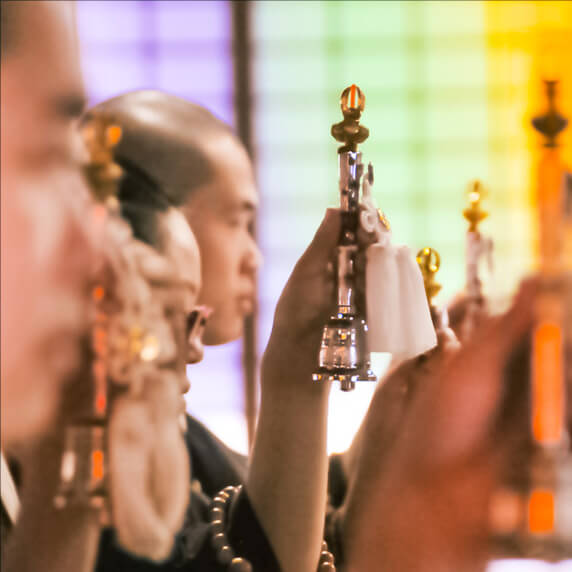
Kongo Sect hymns borrow to some extent from the Yamato and Myo’on styles of singing, which existed since ancient times, but they also represent a unique form the mode, scale, and notation of which have been uniquely compiled since 76th generation high priest Shun’no Sogabe (of Amanosan Kongoji Temple, Kawachinagano, Osaka) was appointed the supervisor of Kongobuji hymn singing in 1929. This led to the further refinement of the school’s style and methodology, with new lyrics and compositions being made. Today, Kongo Sect Hymns feature unique, memorable pieces unheard anywhere else. This hymnal style has influenced not only Koyasan Shingon but even other schools, becoming an emblem of Mount Koya and its monks.
One of the features of Kongo Sect hymns is the presence of Yosencho, namely, that many of the hymns feature major keys as in Western music, and the compelling melody used therein. Each song has unique singing directions, using special techniques like “shiori,” “oshi,” “atari,” and “mawashi.” There are also different sub-genres, such as hymns that are sung renditions of Japanese poetry forms, songs of praise with 5-7 meter and 7-5 meter, and hymns meant for pilgrimages.
There are five tones: kyu, sho, kaku, chi, and u. The scale has twelve pitches, each ascending in three steps. This is equivalent to a thirty-six pitch scale, but only twenty-five of those pitches are actually used in compositions.
Tokyo classroom: pilgrim hymns
- Date
-
Second and fourth Wednesday of the month
- Time
-
Afternoon session: 1:00PM–2:20PM, followed by a 20 minute break, then continuing from 2:20PM–4:00PM
Evening session (for beginners): 6:30–8:00PM
- Location
-
3-15-18, Takanawa, Minato-ku, Tokyo, 108-0074
Mount Koya Tokyo branch temple
TEL: 03-3441-3338
FAX: 03-3447-2243
- Entrance fee
-
Afternoon session: ¥30,000 annually (two ¥15,000 installments)
Evening session ¥24,000 annually (¥2,000 monthly)
Dues can be paid bi-annually or monthly. Please bring initial dues to your first session.
- Capacity
-
50 people (observers welcome)
Osaka Classroom: Place of Song
- Date
-
First and fourth Fridays of the month
- Time
-
1:30 PM to 4:00 PM (reception opens at 1:00)
- Location
-
Taiyuji, 3-7 Taiyujicho, Kita-ku, Osaka-shi, Osaka Prefecture, 530-0051
- Course fees
-
¥3,000 (paid in two monthly installments)
- Capacity
-
100 people
Inquiries
お申し込みはお電話にてお問い合わせください。
各教室の開催日程ですが、行事等の都合により日程を変更する場合がございます。詳しくは各教室の 問い合わせ先にお問い合わせ下さい。
- Tokyo Classroom: Tokyo Branch Religious Song Classroom
-
3-15-18 Takanawa, Minato-ku, Tokyo, 108-0074
Koyasan Tokyo Branch
ATTN: Eastern Japan Alliance Religious Song Group
TEL: 03-3441-3338 FAX: 03-3447-2243
- Osaka Classroom: Place of Song
-
Fudoin, 8-15 Hongocho, Yamatotakada,
Nara Prefecture 635-0082
ATTN: Kongo Kinki Alliance Place of Song Team
TEL: 0745-52-1669 FAX: 0745-52-3764
金剛流宗教舞踊
kongo sect religious dance
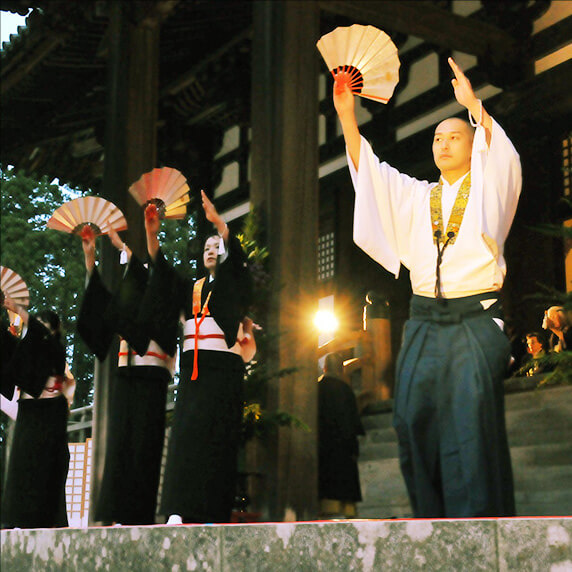
Religious dance is choreographed in tune to hymns of praise. Refresh body and mind by dancing in tune to these soothing melodies. Give your soul a reprieve from the busy everyday with an exciting and contemplative form of dance.
華道高野山
koyasan flower arrangement
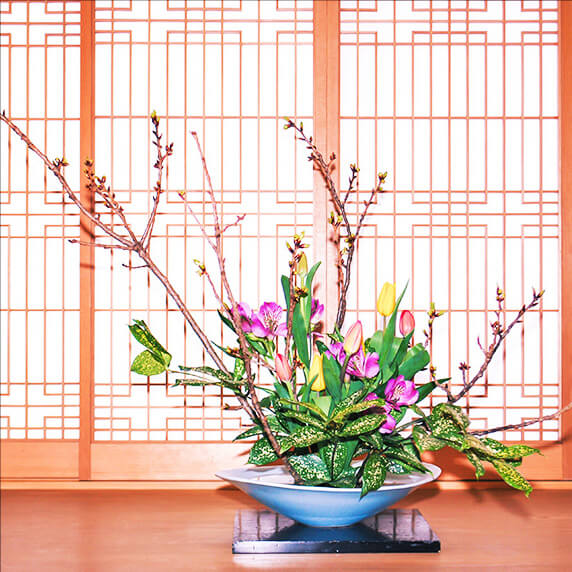
experience01
About our classrooms
If you love flowers and can empathize with their existence, you have the qualifications to join Kado Koyasan. If this is your first time with flower arrangement, you need not worry. We slowly teach you the fundamentals from the beginning, ensuring you can achieve expressive designs. We of course openly welcome experts and those studying other schools.
Tokyo classroom
- Held on
-
First and third Tuesdays
- Location
-
3-15-18, Takanawa, Minato-ku, Tokyo
Tokyo branch temple
- Telephone
-
03-3441-3338
Details and application forms
for 2023 Tokyo ikebana classroom
Osaka classroom
- Held on
-
First and third Wednesdays
- Location
-
3-7 Taiyuji-cho, Kita-ku, Osaka-shi, Osaka-fu
Taiyuji
- Telephone
-
06-6311-5480
Details and application forms
for 2023 Osaka ikebana classroom
Inquiries
We take registration inquiries by telephone. You can contact the Tokyo/Osaka ikebana classrooms above or the Daishi Kyokai directly.
Note that the schedule for each classroom may be subject to change based on other events taking place. For details, please contact the classroom or the Daishi Kyokai.
- Tokyo ikebana classroom
-
3-15-18, Takanawa, Minato-ku, Tokyo, 108-0074
Mount Koya Tokyo branch temple
Eastern Japan Mount Koya Flower Arranging Group: Ikebana Classroom
TEL: 03-3441-3338 FAX: 03-3447-2243
- Osaka ikebana classroom
-
3-7 Taiyuji-cho, Kita-ku, Osaka-shi, Osaka-fu, 530-0051
Within Taiyuji
Western Japan Mount Koya Flower Arranging Group: Ikebana Classroom
TEL: 06-6311-5480 FAX: 06-6312-5454
森林セラピー体験ツアー
forest therapy tours
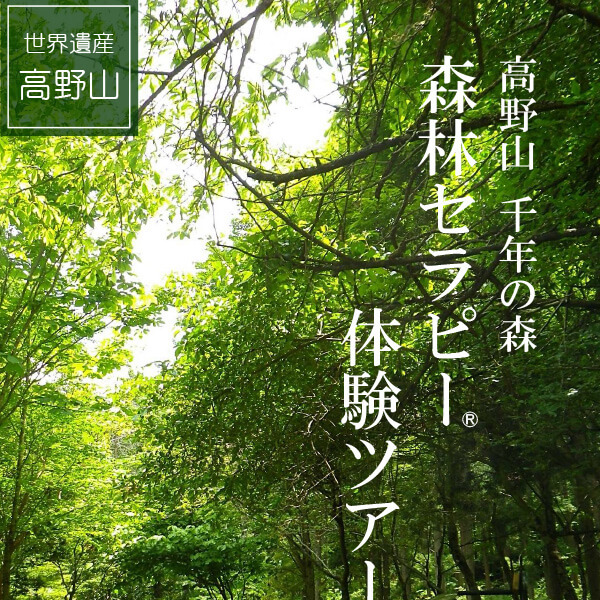
Forest therapy is a program that lets you regain your energies amidst the natural beauty, scents, sounds, and textures of the forest. Witness nature with your five senses as you unwind.
In addition to being designated a World Heritage Site for the sacred areas and temple roads along the Kii Mountains, Mount Koya was also been designated a forest therapy site in 2007.
Enjoy the crossroads of history and nature on Mount Koya forest therapy tours.

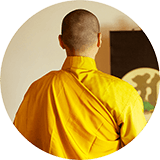 Ajikan
Ajikan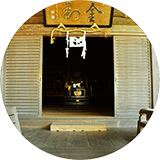 Sutras
Sutras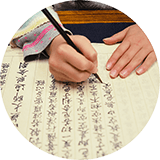 Shakyo
Shakyo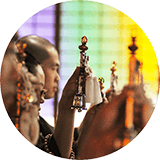 Song of Prise
Song of Prise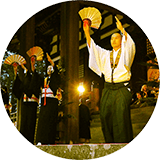 Kongo Sect Religious Dance
Kongo Sect Religious Dance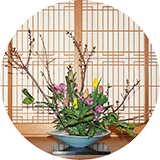 Flower arrangement
Flower arrangement